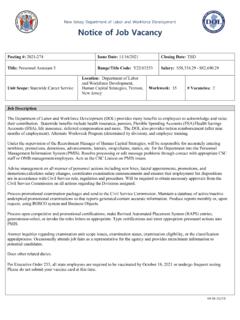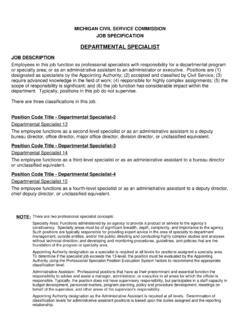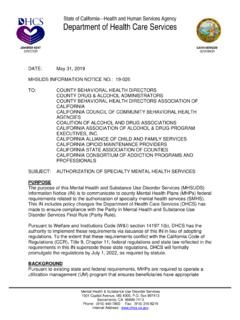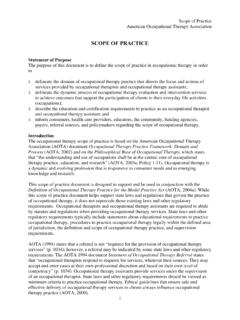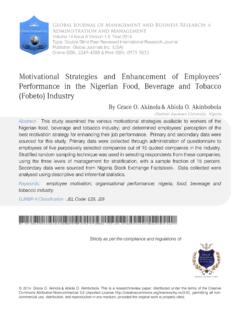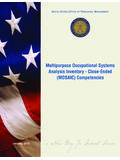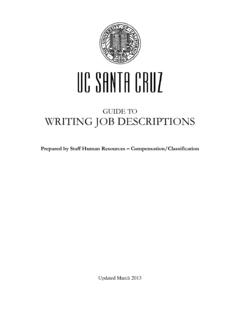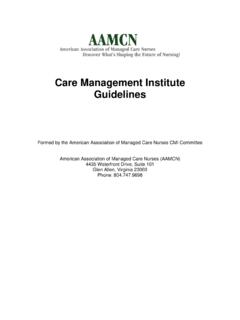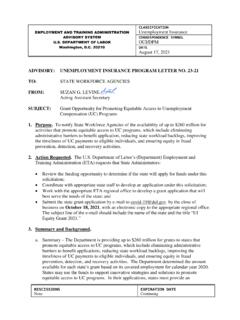Transcription of Learner Readiness Why and How Should They Be Ready?
1 LEARN Journal : Language Education and Acquisition Research Network Journal, Volume 13, Issue 1, January 2020 268 Learner Readiness Why and How Should They Be Ready? Linchong Chorrojprasert Graduate School of Human Sciences, Assumption University of Thailand Abstract This article aims to serve as a gentle reminder to all of us- English teachers - that there are other multifaceted factors that contribute to our learners achievements besides curriculum and instruction. There are other significant facts and observations that Should be noted and considered beyond those dictated in the Quality Assurance requirements.
2 There are other issues that we must pay attention to in our class preparation besides what is prescribed on the policies by the schools, the Ministry of Education or the government agenda. Among these issues is Learner Readiness . While we stay focused on whether or not the learners are acquiring the target knowledge and skills, we Should intently put in some thoughts and efforts on the development of our students learning competency and intellectual character, if not to initiate and motivate them to become each an effective and self-regulated Learner .
3 Discussions the importance of learning Readiness on learning outcomes and the approaches teachers may consider to tap into these notions and enhance our teaching practices and their learners achievements are included. Keywords: Learner Readiness , self-regulated learning Introduction In classrooms where the teacher does not adjust the learning tasks and teaching approaches to the students levels of Readiness and teaches only to the majority- the average students- some students will be bored from lack of challenge, and others may be placed under stress from too great a challenge. Therefore, we need to consider where our learners are in relation to the learning objectives and plan the learning experiences just beyond the skill level of each student.
4 learners are more likely to be actively engaged in the learning, rise to the challenge, and build up a sense of self-confidence as they approach the target tasks if they feel that they have a chance to succeed. So when the levels of Readiness have been considered- of course it is next to impossible to say that we can consider each and every Learner individually - learners of various levels of learning Readiness can be identified and appropriately grouped. Then the tasks and experiences can be designed to accommodate the learners at their levels of learning competency.
5 Recent research and various studies have provided evidence that educational interventions work best when Learner Readiness is noted and Learner Readiness strategies if embedded within instruction can help enhance the capacities and skills of learners , including those with learning difficulties and language issues (Aguilar & Kim, 2019; Bozkurt & Arslan, 2018; Hsieh & Hsieh, 2019; Kartal & Balcikanh, 2019) According to numerous advocates of Learner Readiness , a magnitude of terms and concepts are coined and deployed. Among these, some of those that predominate are Learner autonomy, self-efficacy, self-regulation or self-directed learning, responsible learning, Learner s attitudes and beliefs toward language acquisition, Learner s intellectual character and learning strategies .
6 The notions of Learner Readiness are often integrated and intertwined with Learner autonomy and self-regulated learning when used to define the process in which learners are able to actively and effectively control and monitor their motivation, cognition and behaviors and successfully complete the target academic tasks (Blidi, 2017; Kuhn & Cavana, 2012; Palfreyman & Smith, 2003; Zimmerman, 2011). LEARN Journal : Language Education and Acquisition Research Network Journal, Volume 13, Issue 1, January 2020 269 Learner Readiness in Various Aspects In general context, Learner Readiness is often used to define the ability of a Learner to acquire knowledge and initiate in behavior change which lead to effective and successful learning outcomes.
7 In terms of educational policies and implementation, Learner Readiness is closely related to early childhood education and school Readiness as it refers the capacity to engage actively in the learning process. It suggests that for young learners to benefit from educational interventions at school, they must be constantly and always ready and at their fullest potential to learn. Factors that can and may pose as threats to successful learning outcomes include poor health, malnutrition, and emotional instability or distress as well as other physical, social, economic and environmental ills such as prenatal exposure to drugs and other toxic substance; child abuse and neglect; unsafe communities; and family instability and dysfunction (Copple, Deich, Brush, & Hofferth, 1993).
8 Another prominent proposition that cannot be neglected in any discussion of Learner Readiness is the disposition for learning- a characteristic that individuals Should have or already acquired before the start of any learning situation if optimal benefits are expected for the time and effort invested. This includes some dominant constructs, namely: a desire to learn; a positive attitude toward the learning situation; a willingness to make the investment of time and effort that is necessary for learning, the ability to persevere, an understanding of the importance and value of learning (Buckingham Shum & Deakin Crick, 2012; Perkins & Tishman, 2001; Tishman & Perkins, 1993).
9 Though Buckingham Shum & Deakin Crick (2012) contended that the term disposition may be imprecise when discussed in theory or practice, they agreed that it was indeed associated with the enduring tendency to behave in a particular way and the individual s motivation, affect, valuing and cognitive resources. Furthermore, there are those proponents of desirable characteristics of effective learners which overlap with the notions of learning Readiness . They contend that there are four characteristics that a Learner Should possess in order to learn effectively- particularly in classroom setting: disposition for learning, adequate cognitive functioning, adequate knowledge base for the content being presented and adequate study skills and strategies (Falik & Feuerstein, 1993).
10 However, there is no guarantee that learning will take place -even when these four characteristics are accessible. Meaningful learning is not likely to take place unless the circumstances in which the individual finds himself/herself make it possible for the individual to apply them. All these extraneous factors included in these "circumstances" could be personal situations the Learner s emotional or physical state, geographic location, curriculum offerings, quality of instruction just to name a few. We cannot discuss Learner Readiness in the context of English language education without mentioning some of the significant propositions relevant to the analysis of language acquisition language learning strategies (Oxford, 1990) and Learner personality traits (Chamorro-Premuzic, Furnham, Dissou, & Heaven, 2005; Furnham, Chamorro-Premuzic, & McDougall, 2003; Oxford, 1990).










